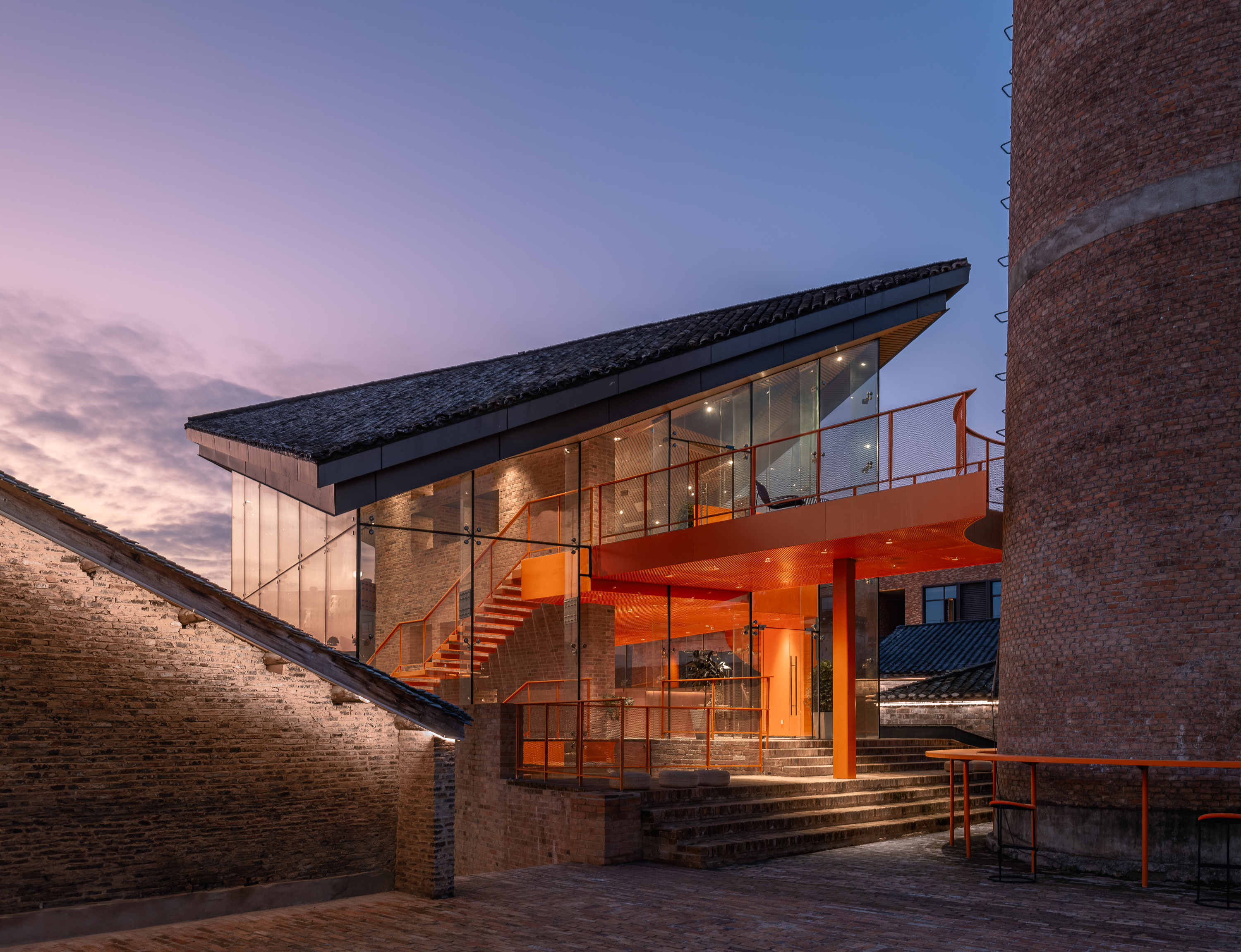

设计单位 刘克成设计工作室+众建筑
项目地点 江西景德镇
建成时间 2022年
建筑面积 1340平方米
本文文字由众建筑提供。
景德镇作为中国的“瓷都”,有着1000多年制作瓷器的历史。本项目为景德镇御窑厂片区杨华弄院落的更新改造,采用“插建/件”的方法为指导,在尊重原有地段历史特色的基础上,进行新建建筑的“插建”和旧有建筑内部的“插件”设计,来达到新功能的置入,以及场地的活化更新。
The regeneration of an old porcelain factory property in the heart of Jingdezhen’s Imperial Kiln Historic District is guided by “Plugin Architecture & Unit” approach to historic preservation and urban regeneration. This method involves placing architectural insertions within and adjacent to existing buildings to revitalize the site while incorporating and respecting its historical elements. Jingdezhen, known as China’s “Porcelain Capital,” has a history of over 1,000 years in ancient porcelain production.
杨华弄院落位于御窑厂片区的中心位置,紧邻西侧的御窑博物馆和御窑厂遗址,以及北侧的徐家窑。院落东南角为烟筒广场,是该区域较为重要的开放空间节点,连接各方巷道;南侧的杨华弄巷道很窄,但很好地保持了历史原貌。
The site is located in the center of the Imperial Kiln historical area, adjacent to Chimney Square. To the west, is the Imperial Kiln Museum and the Imperial Porcelain Factory archeological site; to the north, is the Xu Family Kiln, which is the oldest, most complete, and largest wood-fired kiln site preserved in Jingdezhen.


院落改造的插建最重要的是烟筒咖啡厅的置入。一座三层的双坡顶玻璃建筑,包含展览和咖啡空间,在形成标志性的同时,与周边历史环境无缝融合,成为公共空间的重要锚点。玻璃外立面的透明性彰显了一种开放性,与周边坚固的传统砖墙建筑形成鲜明的对比。对角双坡的屋顶采用传统青瓦做法,犹如漂浮的大伞一般。屋顶之下的透明空间,连接了院落内外,是烟筒广场公共空间的一种积极延展。
The focal point of the design is a modern architectural landmark that integrates seamlessly into the center of the historic surroundings—a three-story glass building topped by a double-pitched roof. Housing exhibition spaces and a café, the building serves as a vital anchor in the main public square, harmonizing contemporary design with a deep respect for historical continuity. The transparency of the glass enclosure introduces a sense of openness, contrasting with the solid, traditional buildings nearby. The roof, covered in traditional clay tiles, appears to float above the transparent enclosure, creating a welcoming spatial extension of the public square.



从远处看,烟筒咖啡厅的屋顶从层层叠叠的坡屋顶中凸显出来,与周边传统建筑进行着形式上的对话。公共广场的砖砌地面延伸进入烟筒咖啡厅室内,再转化成大台阶进入内庭院,增强了室内外空间的联系。砖砌铺地成为一种清晰而丰富的台阶景观,不仅可以作为座椅使用,也很好解决了广场和庭院之间的高差。
From a distance, the roof emerges from a sea of surrounding clay-tiled rooftops, engaging in a visual dialogue with Jingdezhen’s traditional architecture. At the level of the public square, the brick paving of the courtyard extends seamlessly from the exterior through the building’s interior, enhancing the connection between indoor and outdoor spaces and bridging old and new. The brick paving transforms into an articulated landscape of steps that double as public seating, gracefully accommodating the elevation change between the public square and the courtyard.




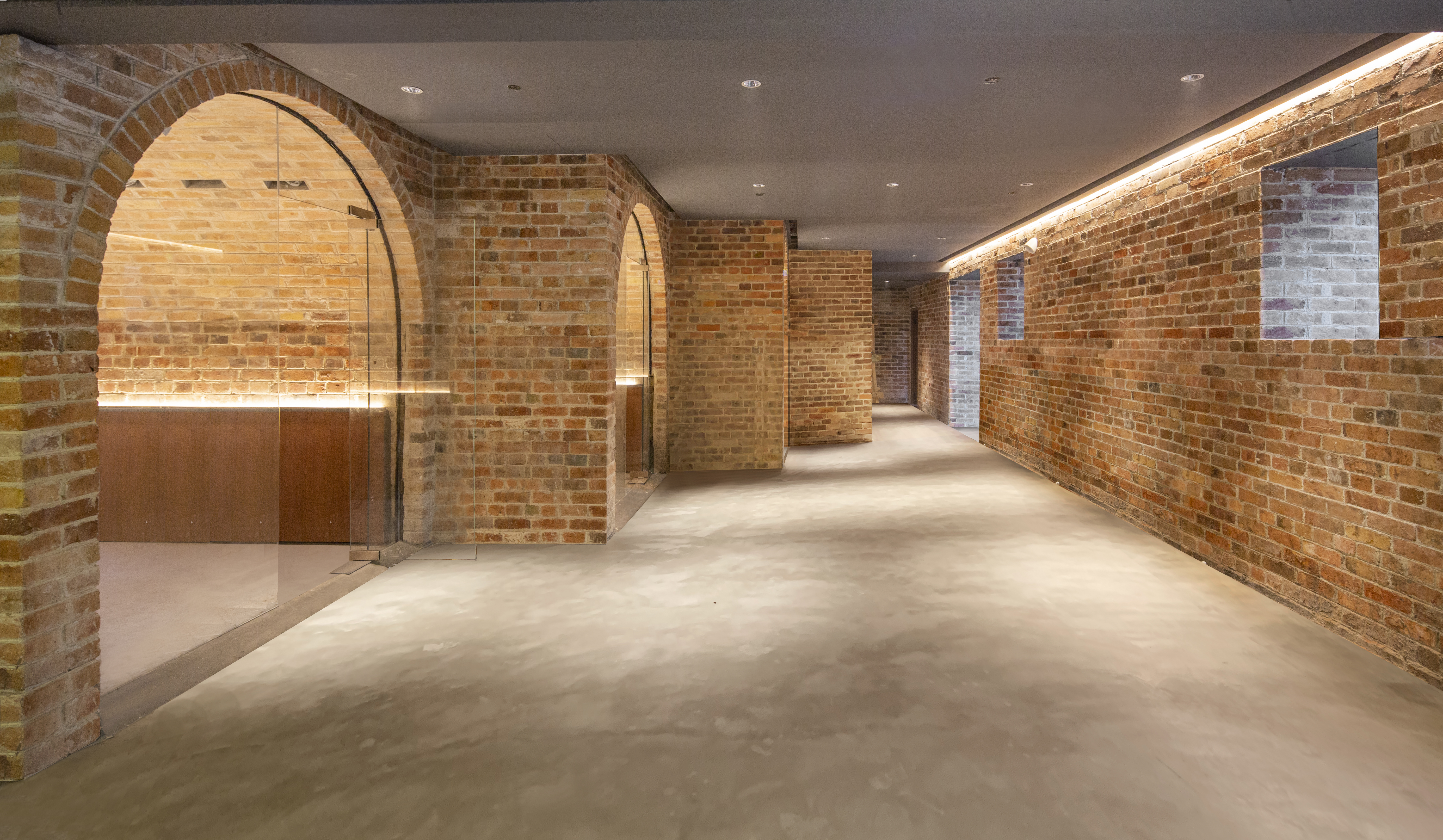
咖啡厅地下一层为砖砌基座,落位于原有建筑基底之上,延续了原有的空间肌理。基座采用砖拱立面和大台阶的做法,是烟筒广场向内院的延伸。同时二层的橙色夹层往烟囱延伸形成室外平台,完成了新建建筑与现有场地完整的锚固。该设计巧妙的融合了新旧元素,在尊重历史环境的同时创造了一个独特而现代的空间地标。
Below, and on the opposite side of the square, barrel-vaulted brick rooms form the façade at the building's base, grounding it firmly in the historical context. On the third floor, a balcony extends towards a large pre-existing chimney, completing the unified composition and reinforcing the building's connection to (a historical remnant of the facility’s past) its historical surroundings. This design thoughtfully merges old and new, creating a landmark that honors its setting while introducing a distinctly modern presence.





围绕咖啡厅透明立面周边的是原有的坯房建筑,采用“插件家”[1]的方式改造为陶瓷艺术家工作坊。原有的砖墙和木结构保存完好,在木结构之间插入预制的功能模块,来满足艺术家的使用需求。卧室、工作室、厨房和卫生间模块增加了新的功能。楼梯和走道也被插入其中,通过连接使空间利用最大化。新的插件与原有建筑风格迥异,但也很好整合了空间和功能。
Surrounding the glass building on three sides are a new restaurant and old porcelain workshops that have been revitalized through the Plugin Architecture approach. The original wood and brick structures remain intact, with new architectural insertions upgrading the old buildings to meet contemporary needs. Inside, these modules provide insulated and conditioned sleeping quarters, office spaces, and meeting rooms. Kitchen and bathroom modules add new functionality. Stairs and walkways are inserted both inside and outside to connect spaces and maximize their use. The new Plugin components are designed as modern insertions, visually distinct from their historic surroundings yet functionally integrated.

原有场地为两个较为封闭的院落,设计将其中一个建筑旋转,将院落空间进行连通。整合后的院落可以从咖啡厅的透明空间进入,也可以通过多处公共通道进入,成为一个有较强开放性的新型公共空间。
To extend public access into the courtyard spaces of the porcelain workshops, one building was rotated to merge the two original courtyards into a single unified space. This reconfiguration allows access from the public square and the glass building to flow through the interior of the courtyard, connecting the entire complex into a cohesive whole.




院落原有建筑类型较为多样,有传统木构的坯房和居住建筑、砖混建筑以及混凝土加木构建筑。改造只拆除少量的后期建设建筑,并在部分拆除建筑的地基上新建建筑。梳理后的院落布局延续了原有院落的肌理关系、保留了原有建筑丰富的多样性,也增加了院落的开放性。
The original structure types of buildings in the courtyard are quite diverse, including traditional timber-framed workshop and residential buildings, brick masonry structures, and concrete structures with timber elements. The renovation only demolished a small number of later-construction buildings, and built new buildings on the foundations of some demolished buildings. The reorganized courtyard layout continues the texture relationship of the original courtyard, retains the rich diversity of the original buildings, and increases the openness of the courtyard.
咖啡厅、餐厅以及陶瓷艺术家工作室三种新的业态功能既有一定分区,又相互混合。这种布局方式有助于搭建新型的公共社群。
The three new business functions of cafe, restaurant and ceramic artist studio are divided into different areas and mixed with each other. This layout is conducive to building a new type of public community.

“插建/件”式改造通过插漏补缺的方式,不仅延续了原有院落的空间关系,也最大限度保留了原有传统建筑的特色,新旧建筑相得益彰。
“Plugin Architecture & Unit”renovation not only continues the spatial relationship of the original courtyard by filling in the gaps, but also retains the characteristics of the original traditional buildings to the greatest extent, so that the new and old buildings complement each other.
咖啡厅为三层建筑,整体构成包括砖砌的底座、双坡大屋顶,以及夹在之间的通高砖墙和橙色结构体。
The cafe is a three-story building with a large brick base, a large double-sloped roof, and a full-height brick wall and orange structure in between.



一层咖啡厅为主要入口空间,有一个回形吧台,其三面为通透的玻璃幕墙,有着绝佳的视线,一面为砖墙设计有多个展示窗口。北侧有室外螺旋楼梯可通至二层。
The first floor cafe is the main entrance space, with a circular bar counter, three sides of transparent glass curtain walls, with excellent sightlines, and one side of a brick wall with multiple display windows. There is an outdoor spiral staircase on the north side leading to the second floor.
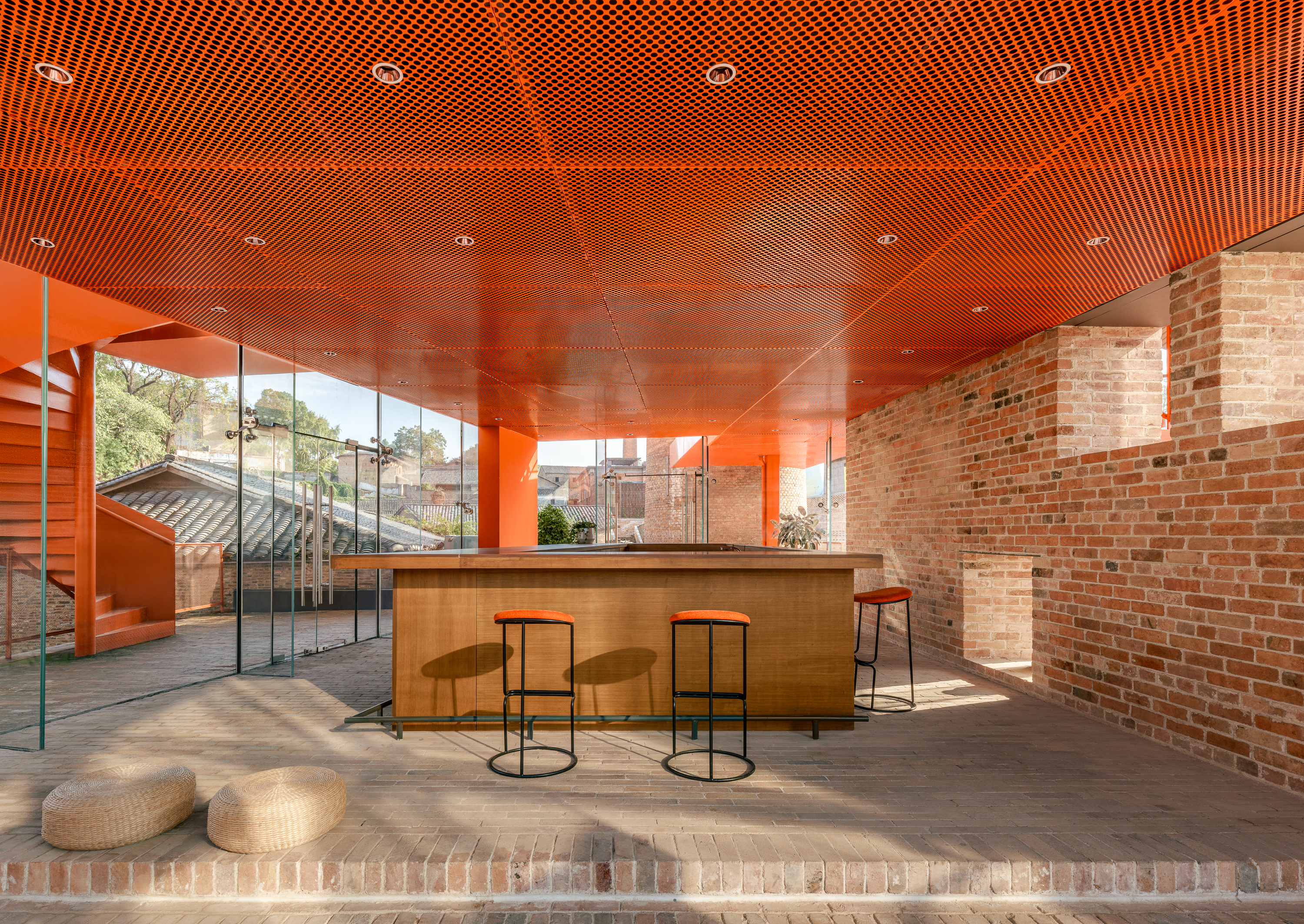
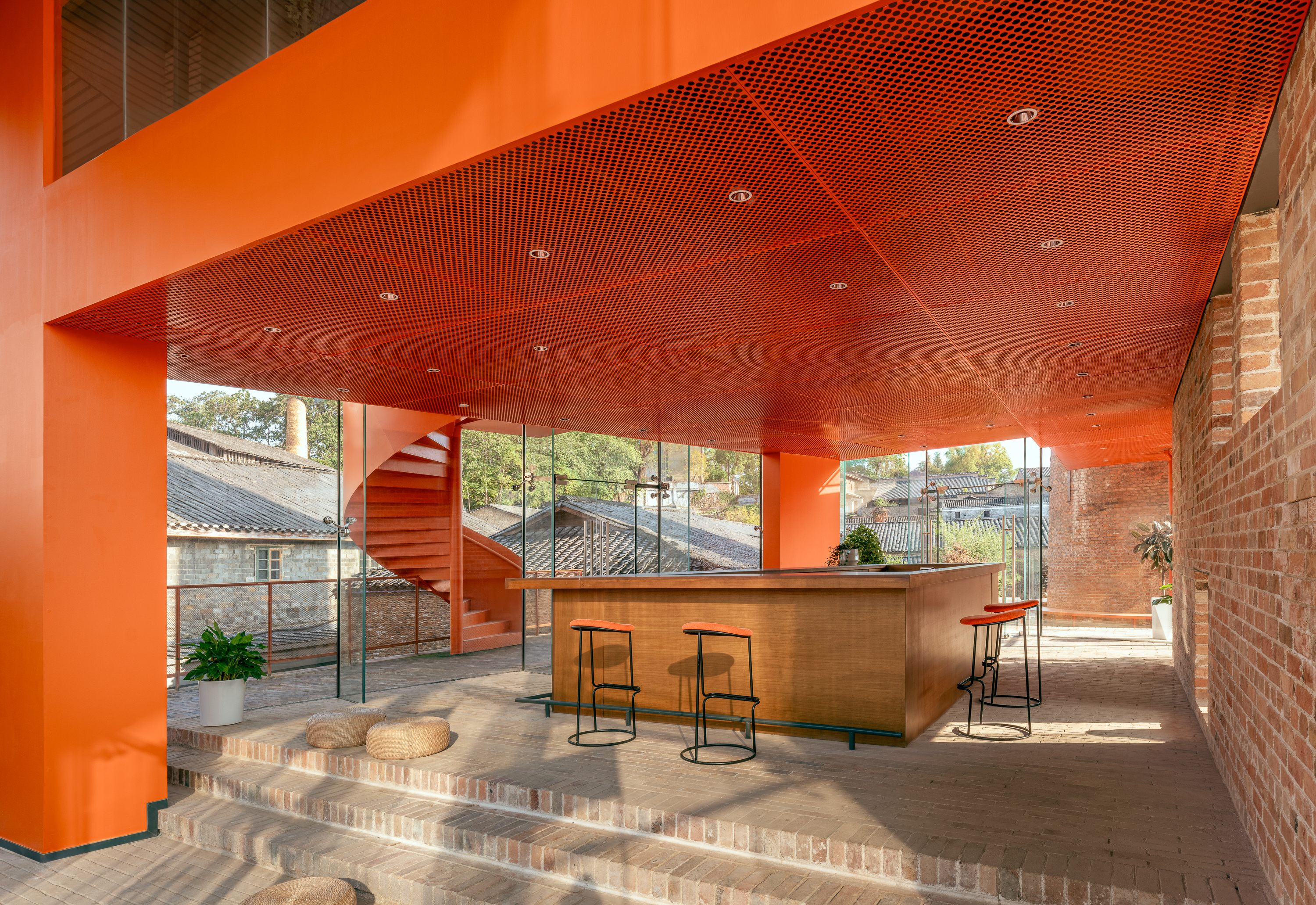

砖砌的厚墙北侧为联系上下的直跑梯,踏步由厚墙直接悬挑出来。砖墙与玻璃幕墙围合出一个三角侧厅,三层通高,用于布置临时展览。
On the north side of the thick brick wall is a straight staircase connecting the upper and lower floors, with the steps cantilevered directly from the thick wall. The brick wall and the glass curtain wall enclose a triangular side hall with three floors, which is used to arrange temporary exhibitions.


二层为手冲咖啡区和一个有着三角天窗的玻璃包间。朝向西侧的挑空处设有通长吧台,可远眺内院以及远处连绵的坡屋顶。
The second floor is a hand-brewed coffee area and a glass private room with a triangular skylight. A long bar is set at the empty boundary facing the west, overlooking the inner courtyard and the continuous sloping roofs in the distance.


地下一层布置有三个拱形空间,是三个不同进深的包间,可容纳不同的活动需求。
There are three arched spaces on the underground floor, which are private rooms of different sizes that can accommodate different activity needs.

咖啡厅的对角双坡屋顶约15×12米见方,最大出挑超过9米,仅落于3颗钢柱顶。屋面结构类似伞形结构,采用围绕钢柱布置环桁架的方式,环桁架周边有伸臂桁架出挑。屋面桁架采用圆管相贯焊的方式连接,并采用球铰支座落于钢柱顶。
The diagonal double-slope roof of the cafe is about 15x12 meters square, with a maximum overhang of more than 9 meters, which only rests on the top of three steel columns. The roof structure is similar to an umbrella structure, with ring trusses arranged around the steel columns, and cantilever trusses around the ring trusses. The roof trusses are connected by intersecting welding of circular tubes and are supported on the top of steel columns with ball joints.


大屋顶同时覆盖了室内和室外的公共空间,并通过大悬挑强化了视觉的漂浮感。
The large roof covers both indoor and outdoor public spaces, and the large cantilever strengthens the visual sense of floating.
餐厅院落的三栋原有建筑各有特色,紧挨广场的是一栋歇山顶木构建筑,北侧是一栋两层高的双坡砖混建筑,转角是一栋方形双坡木构建筑。设计通过“插建”一个U型连廊连接三个原有建筑,并在原有建筑内部置入蓝绿色入口及楼梯系统,将人流引入一层主体餐饮空间。转角建筑则插入了新的蓝绿色门窗系统,以增强室内外的联系。
The three original buildings in the restaurant courtyard have their own characteristics. Next to the square is a wooden building with a hip roof, on the north side is a two-story double-slope brick-concrete building, and at the corner is a square double-slope wooden building. The design connects the three original buildings by "inserting" a U-shaped corridor, and inserts a blue-green entrance and staircase system inside the original building to lead people into the main dining space on the first floor. A new blue-green door and window system is inserted into the corner building to enhance the connection between indoor and outdoor.




新增的蓝绿色楼梯及夹层系统与原有木屋架完全脱开,有自己的结构体系,并在效果上与原有木屋架形成较大差别,来突出可逆性改造的设计策略。
The newly added blue-green staircase and mezzanine system are completely separated from the original wooden structure. They have their own structural system and are visually quite different from the original wooden structure, highlighting the design strategy of reversible transformation.


院落西侧为陶瓷艺术家工作室,采用“插件家”[1]的预制化方式进行改造。原有木屋架完全不动,在一层布置工作+卫生间模块和厨房模块,在高处布置卧室模块,工作模块上方设置木平台作为茶室空间。
The west side of the courtyard is a group of ceramic artist studios, which were renovated using the prefabricated "plugin house" system. The original wooden frame was completely retained, and the work + bathroom module and kitchen module were arranged between wooden structures on first floor, and the bedroom module was arranged between the mezzanine wooden structures. A wooden platform was set above the work module as a tea room space.


预制模块有清晰的气候边界,有着良好的保温性和密闭性,有独立的空调系统,可以在景德镇冬天极冷、夏天极热的气候下提供较为舒适的室内环境。
The prefabricated modules have clear climate boundaries, good thermal insulation and airtightness, and an independent air-conditioning system, which can provide a more comfortable indoor environment in Jingdezhen's extremely cold winters and extremely hot summers.


御窑厂的杨华弄院落更新在延续原有空间肌理、保留原有传统建筑的基础上,通过“插建/件”式的方法,将封闭的院落空间进行重构和激活,来匹配新的功能业态和使用方式,是一种联结历史和未来、可持续的历史街区更新方法。
The renovation of the Yanghua Lane courtyard in the Imperial Kiln Factory continues the original spatial texture and retains the original traditional architecture. Through the“Plugin Architecture & Unit” method, the closed courtyard space is reconstructed and activated to match the new functional formats and new usage methods. It is a method of connecting history and the future, and a sustainable historical block renewal method.
设计图纸 ▽






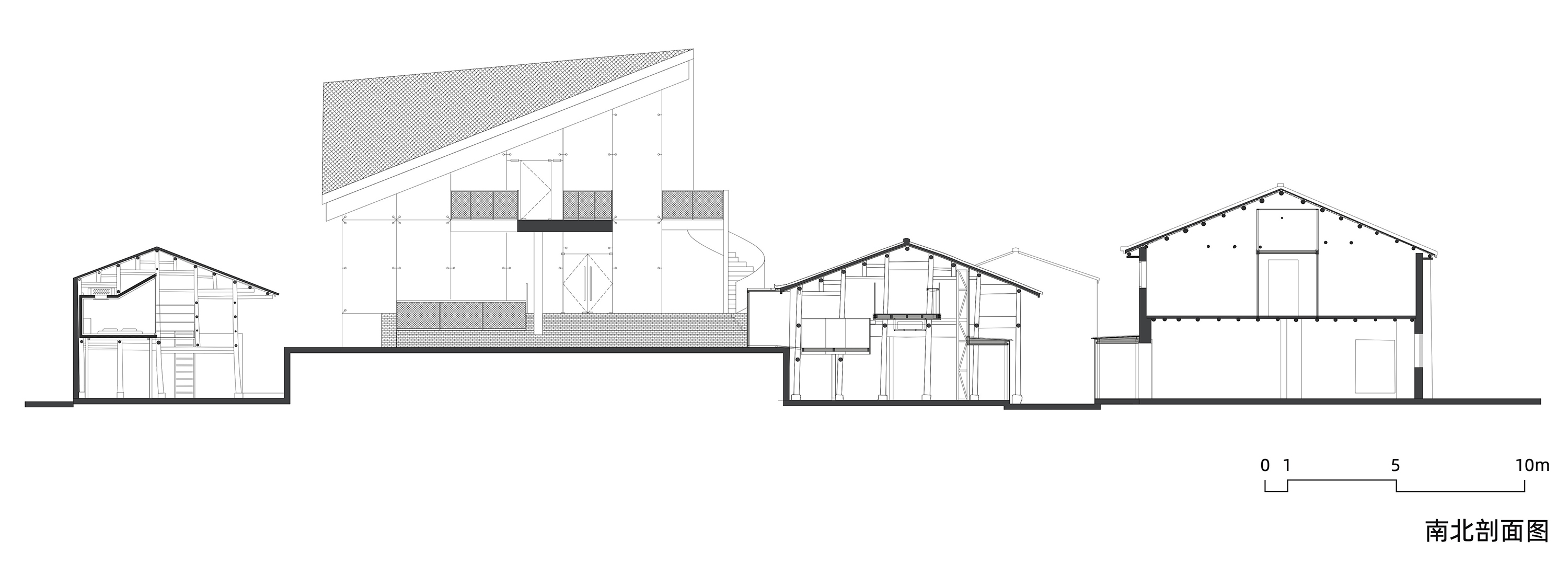
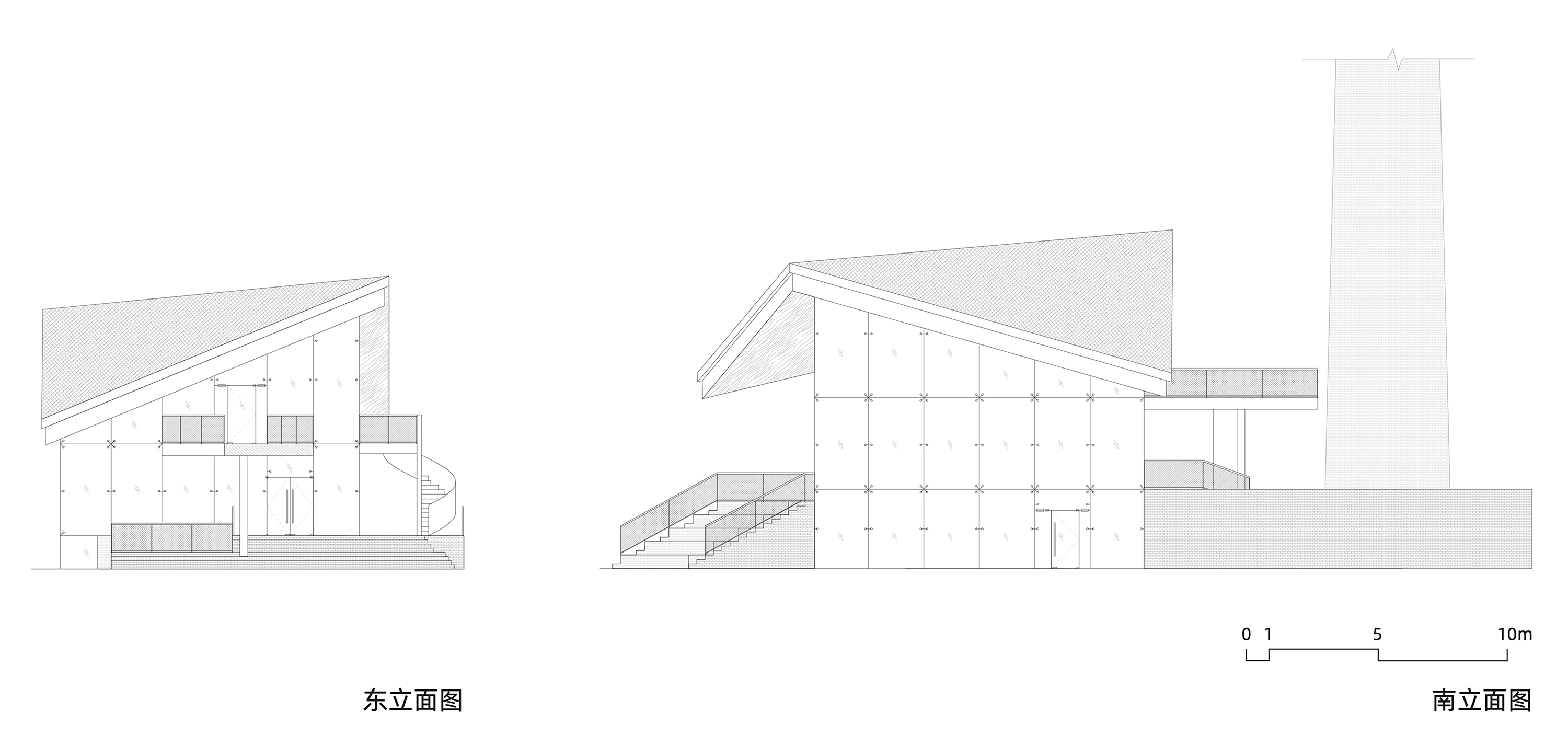
注释:
[1] “插件家”发展自众建筑的“内盒院”。预制的“插件板”系统具有很好的防水性能,可用在室外;建造无需其他结构,板材自身即为结构。插件预制模块板集结构、防潮、保温、设备、室内外饰面于一体,整体厚度只有50毫米。板材之间用锁钩连接,几个非专业人员用简单的工具即可在一天内完成搭建。
完整项目信息
业主:景德镇陶文旅集团
地点:景德镇御窑厂片区
设计单位:刘克成设计工作室+众建筑
建成时间:2022年
规模尺度:占地面积1630平方米,建筑面积1340平方米
设计主持(刘克成设计工作室):刘克成,肖莉
设计主持(众建筑):何哲,沈海恩(James Shen),臧峰
项目负责:袁樱子,张萌
项目团队:杨全越,杨茜,黄俐颖,张梦媛,周时敏,韩笑,刘一新,王赫,温皓,蒋颖、刘伊丰
结构设计:刘粟/北京首昂建筑结构工作室
设备设计:西安新会众建筑工程设计咨询有限公司
摄影:朱雨蒙,众建筑
图纸绘制:张萌,袁子书
版权声明:本文由众建筑授权发布。欢迎转发,禁止以有方编辑版本转载。
投稿邮箱:media@archiposition.com
上一篇:SOM竞赛第一名方案:深圳中集大厦,空中有花园
下一篇:二等奖方案|南头小学改扩建工程项目 / 局内设计